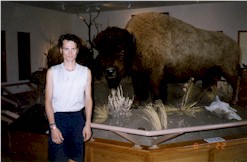|
The American Bison symbolized strength, stability, and freedom. However, only eighty-one years after the Lewis and Clark Expedition passed through the plains of the Missouri River, the Bison existence was sparse. Washington D.C. was concerned and sent William Hornaday stumbling over Bison bones to Montana. Mr. Hornaday took twenty-four buffalo back to the Smithsonian. Only six were mounted, preserving the only visual life size bison for our country. A 5’9” 2,200 pound bull was one of the six. The “big Bull” became famous as an inspiration of strength for several national symbols and government issues. Coins and paper currency, the Great Seal of the Department of Interior, postage stamps and the National Park Service badge bear the likeness of the big bull in the Hornaday collection. The “Big bull” takes center stage on the Lewis and Clark ten-dollar bill. It wasn’t until 110 years later, in 1996 that these six mounted buffalo found there way back to Montana, now forever on permanent display at the Agricultural Museum of the Northern Great Plains in Fort Benton, the birthplace of Montana. Father and I continued in freedom traveling south of Fort Benton along the Missouri. My hand held the newly purchased “big bull” belt buckle with the 1937 Bison nickel of Indian face on back. I walked away holding the strength, stability, and freedom of the American Bison.
|
|||||||||||||
|
|
||||||||||||||

